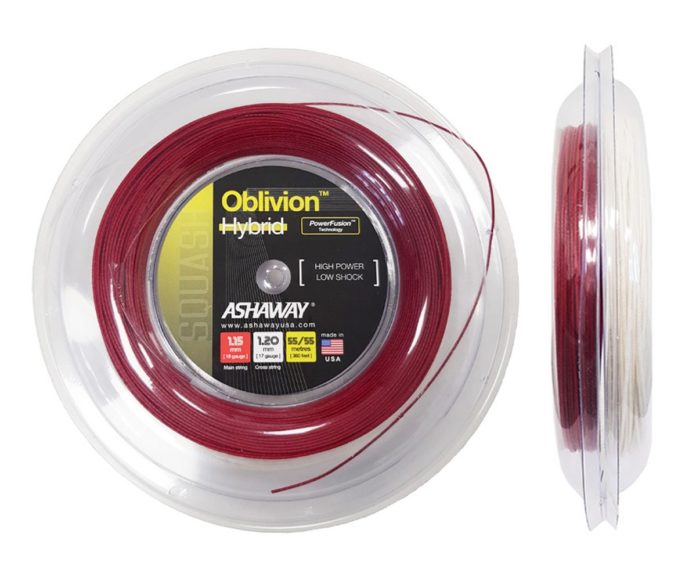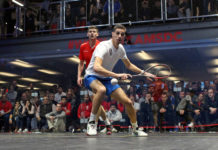By Steve Crandall
Vice President, Sales & Marketing
Ashaway Racket Strings
Hybrid stringing for squash? In a word, yes. Hybrid stringing is coming to squash. And for very good reasons as we shall see.
First, a bit of background. For those of you who may not know, hybrid stringing is the practice of using one distinct string for the mains (the vertical strings) and another for the crosses. This is not to be confused with ‘composite stringing,’ which uses a single string made of two different materials, or ‘hybrid tensioning,’ which also uses a single string, but strung at different tensions for mains and crosses.
Hybrid stringing first became popularized in tennis by eight-time Grand Slam champion Andre Agassi who suddenly started using a braided aramid string in his mains for durability and natural gut in his crosses for playability, winning his first Grand Slam with this pairing. But the real spur to hybrid stringing came with the evolution of racquet head designs in tennis, that led to a number of string-related issues.
Players looked to alternative stringing approaches to optimize these new racquet geometries and get the most out of their racquets for their preferred styles of play. While squash racquet head designs may not have changed as radically over the years, changes in racquet materials, differing head shapes, and changing string patterns are having a similar effect. Here’s how the issues played out in tennis.
As racquets first evolved from wood to composites and then grew in size and shape, string tensions increased dramatically—sometimes up to 80 lbs.—to maintain optimum topspin and control of the ball, and duplicate the feel of a standard size racquet. This led to the development of alternative stringing techniques, one of which was hybrid stringing.
While oversized racquets helped players improve their game, they also had an unwanted consequence—premature string wear and breakage. Due to the increased surface area, oversized racquets use more string and the string pattern is generally more open. This results in greater string movement during play and more friction between strings. With the evolving “topspin” game, increased tension and string movement, higher caliber players discovered their strings were snapping with disconcerting frequency. The practice of hybrid stringing was adapted to improve the durability and useful life of racquet string.
Another unintended consequence of larger racquet heads was what has become known as the ‘trampoline effect.’ Imagine you are doing a leg workout, bouncing happily away on one of those little trampolines you see in the gym. Now imagine that between bounces, while you are up in the air, the little trampoline is suddenly switched for a full-sized one: your next bounce, using the same leg force, is going to feel like you’ve been shot out of a cannon.
This loss of control on the larger trampoline is analogous to the loss of ball control players experience when racquet surface area is increased without using a compensating method of stringing. Hybrid stringing was one of the techniques developed to provide a firmer string bed and increased ball control—a good alternative to stringing frames at ridiculously high tensions.
But, you say, squash is a very different game from tennis and racquetball. Look at ball weight alone. A tennis ball weighs in at 58 grams, while a squash ball is a featherweight by comparison at 24 grams.
This is true. But squash players also tend to use thinner strings than tennis players. And while changes in head size have not been so dramatic (a quick Google search shows a range of 460 – 500 cm2), the traditional 14 main/18 cross string pattern is also beginning to change. The same survey showed racquets with 14/16, 14/19 and even 16/19 patterns right from the factory. In a nuanced, light-ball game like squash, these changes can have a significant effect on playability and open the door to hybrid possibilities.
But the biggest argument for hybrid stringing is the same argument used for any change in string: improved performance. Hybrid stringing offers: more variety, another way to optimize that triad of durability, power, and control, and enhance the playability of your racquet to suit your particular game.
Early in 2020 Ashaway introduced the first hybrid set for squash. Incorporating Ashaway’s PowerNick® 18 red for the mains and Powerfusion™ white for the cross strings, Oblivion® hybrid strings offer a high power, low shock combination for amateur and professional players seeking a lively and durable means to generate excellent ball speed and control. They are available in 18 x 18 foot packaged sets and in special double reels containing 195 feet of each string.
In our next column we’ll look closer at technical developments in hybrid stringing for squash and what benefits they may provide.





